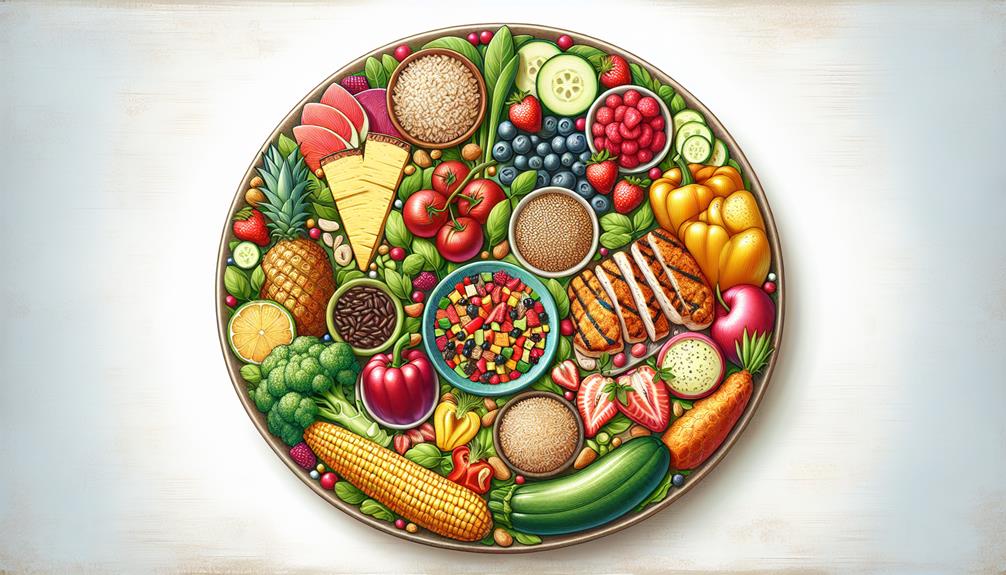Step into the world of gluten-free diet plans, where the road to wellness can be as elusive as chasing shadows. As you navigate the maze of gluten-free options, it's essential to have a reliable guide to help you uncover the secrets of crafting a balanced meal plan that caters to Celiac Disease and gluten sensitivity. But fear not, for within these pages lies a treasure trove of knowledge, tips, and insights, designed to unveil the mysteries of dining out, deciphering food labels, and building a diet that nourishes both body and soul. Get ready to embark on a journey of discovery, where every bite holds the promise of a healthier, gluten-free life.
Key Takeaways
- Celiac disease is an autoimmune disorder triggered by gluten ingestion, causing inflammation and damage to the small intestine.
- Gluten sensitivity shares symptoms with celiac disease but does not involve an immune response or intestinal damage.
- A gluten-free diet involves reading food labels carefully, focusing on naturally gluten-free foods, and experimenting with gluten-free alternatives.
- Building a balanced gluten-free meal plan includes incorporating a variety of flavors and textures, using gluten-free versions of favorite foods, and including plant-based protein sources.
Understanding Celiac Disease and Gluten Sensitivity
Understanding Celiac Disease and Gluten Sensitivity is crucial for anyone looking to follow a gluten-free diet plan. Celiac disease is an autoimmune disorder triggered by the ingestion of gluten, a protein found in wheat, barley, and rye. When individuals with celiac disease consume gluten, their immune system responds by attacking the lining of the small intestine, leading to inflammation and damage. The exact cause of celiac disease is not fully understood, but it is believed to involve a combination of genetic and environmental factors.
On the other hand, gluten sensitivity, also known as non-celiac gluten sensitivity, is a condition where individuals experience symptoms similar to those with celiac disease but do not test positive for the disease. The symptoms of gluten sensitivity can vary widely and may include gastrointestinal issues such as bloating, abdominal pain, and diarrhea, as well as non-gastrointestinal symptoms like headaches, fatigue, and joint pain. It is important to note that gluten sensitivity is different from an allergy or celiac disease, as it does not involve an immune response or cause intestinal damage.
If you suspect you have celiac disease or gluten sensitivity, it is essential to consult with a healthcare professional for a proper diagnosis. They can perform tests, such as blood tests and intestinal biopsies, to confirm the presence of celiac disease or rule out other potential causes for your symptoms. Understanding the causes of celiac disease and recognizing the symptoms of gluten sensitivity is the first step towards managing your condition and adopting a gluten-free diet plan.
The Basics of a Gluten-Free Diet
To follow a gluten-free diet, it is important to understand the basic principles and guidelines. Here are some key points to help you navigate through the gluten-free world:
- Read food labels carefully: Look for products labeled as "gluten-free" or those that do not contain any gluten-containing ingredients such as wheat, barley, or rye. Be aware of hidden sources of gluten, such as malt, modified food starch, and certain flavorings.
- Focus on naturally gluten-free foods: Incorporate plenty of fruits, vegetables, lean meats, fish, eggs, and dairy products into your diet. These whole foods are naturally free from gluten and provide essential nutrients.
- Experiment with gluten-free alternatives: There are many gluten-free grains and flours available, such as rice, quinoa, corn, and almond flour. Explore gluten-free recipe ideas and try new dishes to keep your meals diverse and enjoyable.
- Use gluten-free baking tips: Baking without gluten can be a challenge, but with a few adjustments, you can achieve delicious results. Experiment with gluten-free baking mixes, add xanthan gum or guar gum to improve texture, and consider using alternative binders like applesauce or mashed bananas.
Building a Balanced Gluten-Free Meal Plan

Now that you have a basic understanding of a gluten-free diet, let's focus on how to build a balanced meal plan that meets your nutritional needs while avoiding gluten. Creating a gluten-free grocery list is the first step in planning your meals. Include naturally gluten-free foods such as fruits, vegetables, lean meats, fish, poultry, dairy products, legumes, and gluten-free grains like rice, quinoa, and corn. Look for gluten-free alternatives for bread, pasta, and other grain-based products. Opt for whole grains whenever possible to ensure you're getting enough fiber.
When planning gluten-free meals for picky eaters, it's important to be creative and offer a variety of options. Experiment with different flavors and textures to keep meals interesting. Incorporate gluten-free versions of their favorite foods, such as pizza made with a gluten-free crust or pasta made from gluten-free grains. Offer a range of protein sources, including plant-based options like beans, lentils, and tofu. Don't forget to include a serving of vegetables and fruits with every meal for added vitamins and minerals.
Remember to read food labels carefully to ensure that the products you buy are truly gluten-free. Look for certifications or labels that indicate a product is gluten-free. Planning a balanced gluten-free meal plan may require some extra effort, but with a little creativity and preparation, you can enjoy a variety of delicious and nutritious gluten-free meals.
Tips for Dining Out on a Gluten-Free Diet
When dining out on a gluten-free diet, it is essential to take certain precautions and communicate your dietary needs to ensure a safe and enjoyable experience. Here are some tips to help you navigate dining out while avoiding gluten:
- Research gluten-free menu options: Before heading out, do some research online or call ahead to check if the restaurant offers gluten-free menu options. Many establishments now cater to gluten-free diets, so you can find a variety of choices to suit your preferences.
- Communicate your dietary needs: When you arrive at the restaurant, inform your server about your gluten-free requirements. Clearly explain what foods you need to avoid and ask for their assistance in ensuring your meal is prepared safely.
- Be aware of cross contamination risks: Cross contamination can occur when gluten-free food comes into contact with gluten-containing surfaces or utensils. Ask the server about their procedures for preventing cross contamination and if they have a dedicated area for preparing gluten-free meals.

Are you confused about how to navigate gluten-free food labels and ingredients? Reading gluten-free food labels is essential for individuals with celiac disease or gluten sensitivity to ensure that they are consuming safe and gluten-free products. Understanding how to identify hidden sources of gluten can help you make informed choices and avoid potential health risks.
When reading gluten-free food labels, it is crucial to look for the "gluten-free" label. This label indicates that the product has been tested and certified to contain less than 20 parts per million (ppm) of gluten, which is the threshold considered safe for most individuals. Additionally, you should familiarize yourself with other terms that may indicate the presence of gluten, such as "wheat," "barley," "rye," or "oats" if not specified as gluten-free.
Identifying hidden sources of gluten can be challenging, as gluten can be found in various food additives and ingredients. Some common hidden sources of gluten include malt, modified food starch, hydrolyzed vegetable protein, and certain flavorings. It is important to carefully review the ingredient list and look for any potential sources of gluten.
Frequently Asked Questions
Are There Any Gluten-Free Alternatives to Common Foods Like Bread and Pasta?
You can find gluten-free bread alternatives like rice bread, cornbread, or quinoa bread. As for pasta substitutes, try options like rice noodles, chickpea pasta, or zucchini noodles.
Can I Still Consume Grains on a Gluten-Free Diet?
Yes, you can still consume grains on a gluten-free diet. There are gluten-free grain options available, such as quinoa, rice, and corn. These grains can be a nutritious and tasty part of your gluten-free meal plan.
How Long Does It Take for Symptoms to Improve After Starting a Gluten-Free Diet?
When starting a gluten-free diet, it may take time for symptoms to improve. The time frame varies for each person, but typically, dietary adjustments should lead to noticeable improvements within a few weeks.
Are There Any Hidden Sources of Gluten That I Should Be Aware Of?
You should be aware of cross contamination risks when following a gluten-free diet. Hidden sources of gluten can be found in foods that are not labeled gluten-free and in foods that are processed in facilities that also handle gluten-containing products.
Can I Still Enjoy Desserts and Sweets on a Gluten-Free Diet?
You can definitely satisfy your sweet tooth on a gluten-free diet! Look for gluten-free dessert recipes online and get creative in the kitchen. When dining out, ask for tips on finding gluten-free sweets at restaurants. Enjoy!
Conclusion
So there you have it, folks. Gluten-free diet plans, the latest trend that's sweeping the nation. Because who needs wheat when you can have cardboard-flavored substitutes? But hey, if you have celiac disease or a sensitivity, this guide might actually be helpful. Just remember to always read those confusing food labels and be prepared for some interesting dining experiences. Good luck on your gluten-free journey, may your taste buds find something worth savoring!













